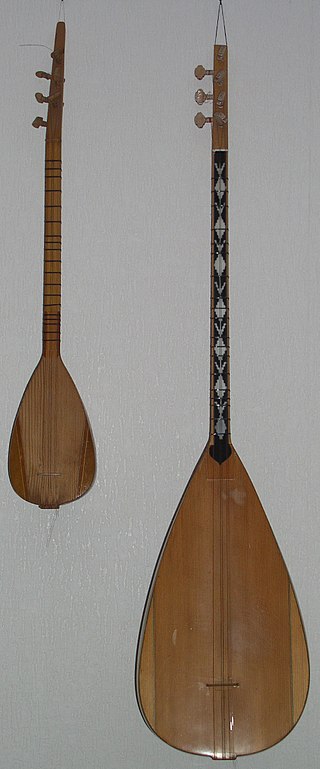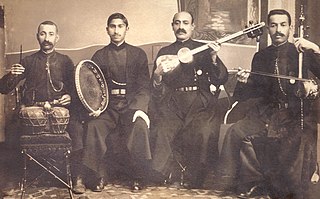
The bağlama or saz is a family of plucked string instruments, long-necked lutes used in Ottoman classical music, Turkish folk music, Turkish Arabesque music, Azerbaijani music, Kurdish music, Armenian music and in parts of Syria, Iraq and the Balkan countries.

Azerbaijani music is the musical tradition of the Azerbaijani people from Azerbaijan Republic. Azerbaijani music has evolved under the badge of monody, producing rhythmically diverse melodies. Music from Azerbaijan has a branch mode system, where chromatisation of major and minor scales is of great importance.

The kamancheh is an Iranian bowed string instrument used in Persian, Azerbaijani, Armenian, Kurdish, Georgian, Turkmen, and Uzbek music with slight variations in the structure of the instrument. The kamancheh is related to the rebab which is the historical ancestor of the kamancheh and the bowed Byzantine lyra. The strings are played with a variable-tension bow.

The duduk or tsiranapogh, is an ancient Armenian double reed woodwind instrument made of apricot wood. It is indigenous to Armenia. Variations of the Armenian duduk appear throughout the Caucasus and the Middle East, including Azerbaijan, Georgia, Russia, Turkey, and Iran. Duduk, Balaban, and Mey are almost identical, except for historical and geographical differences.

The davul, dhol, tapan, atabal or tabl is a large double-headed drum that is played with mallets. It has many names depending on the country and region. These drums are commonly used in the music of the Middle East and the Balkans. These drums have both a deep bass sound and a thin treble sound due to their construction and playing style, where different heads and sticks are used to produce different sounds on the same drum.

The tar is a long-necked, waisted lute family instrument, used by many cultures and countries including Iran, Azerbaijan, Uzbekistan, Armenia, Georgia, Tajikistan, Turkey, and others near the Caucasus and Central Asia regions. The older and more complete name of the tār is čāhārtār or čārtār, meaning in Persian "four string",. This is in accordance with a practice common in Persian-speaking areas of distinguishing lutes on the basis of the number of strings originally employed. Beside the čārtār, these include the dotār, setār, pančtār, and šaštār or šeštār.
The culture of Azerbaijan combines a diverse and heterogeneous set of elements which developed under the influence of Turkic, Iranic and Caucasian cultures. The country has a unique cuisine, literature, folk art, and music.

Mugham or Mughamat is one of the many classical compositions from Azerbaijan, contrasting with tasnif and ashik.

Alim Hamza oghlu Qasimov is an Azerbaijani musician and one of the foremost mugham singers in Azerbaijan. He was awarded the International Music Council-UNESCO Music Prize in 1999, one of the highest international accolades for music. His music is characterized by his vocal improvisation and represents a move away from the traditional style of mugham. Qasimov has recorded nine albums, three of which are mugham albums with his daughter, Farghana Qasimova.

Balaban, or balaman is cylindrical-bore, double-reed wind instrument about 35 centimetres (14 in) long with eight finger holes and one thumb hole. This instrument is played in the eastern part of Iran's historic Azerbaijan region as well as in the Republic of Azerbaijan. Balaban, Mey, and Duduk are almost identical, except for historical and geographical differences.

The Lagguti, Lakto, or Laggutu is a Talysh folk percussion slit drum instrument performed in southern regions of Azerbaijan: Lerik, Astara, Lankaran, Masalli and Jalilabad.

The art of Azerbaijani Ashiqs combines poetry, storytelling, dance, and vocal and instrumental music into traditional performance art. This art is one of the symbols of Azerbaijani culture and considered an emblem of national identity and the guardian of Azerbaijani language, literature and music.

The Azerbaijan State Museum of Musical Culture was opened in 1967, in Baku. The goal of the museum is the collection, storage, investigation and popularization of materials related to the musical history of Azerbaijan.

The Azerbaijan State Orchestra of Folk Instruments is the first notable orchestra of folk instruments in Azerbaijan, affiliated with the Azerbaijan State Philharmonic Society. It was created in 1931, on the initiative of Uzeyir Hajibeyov, founder of professional Azerbaijani music, according to principles of the Symphony Orchestra.

The Azerbaijani tar and the skills related to this tradition play a significant role in shaping the cultural identity of Azerbaijanis. The tar is a long-necked, plucked lute, traditionally crafted, and performed in communities throughout the Republic of Azerbaijan. The tar is featured alone or with other instruments in numerous traditional musical styles. It is also considered by many to be the country's leading musical instrument.

Azerbaijani folk music combines the distinct cultural values of all civilisations that have lived in Azerbaijan and Iranian Azerbaijan region.

UNESCO's list of intangible cultural heritage from Azerbaijan includes 15 examples. 13 of them were included in the "Representative List of the Intangible Cultural Heritage of Humatiy", and 2 were included in the "Intangible Cultural Heritage in Need of Urgent Protection". No examples from Azerbaijan were included in the "Register of Good Safeguarding Practices". The Azerbaijani mugham, the first sample from Azerbaijan to be added to the list of intangible cultural heritage of UNESCO, was included in the list in 2008.
Mugham triads — performers of a classic mugham consists who play the national musical instruments of Azerbaijan: tar, kamancheh and daf (tambourine);

The bülban is a historical instrument from the Caucasus, Middle East and Central Asia. It was a reed pipe, with an apricot wood body and tipped with a tubular single-reed. It had 7 fingerholes and a thumbhole and played a diatonic scale from E♭1 to E♭3. By half-covering fingerholes, it could play a chromatic scale. The instrument has been documented in Azerbaijan, and one can be seen in a photo from the mid-19th-century Russian Turkestan.






















